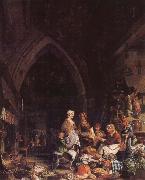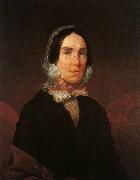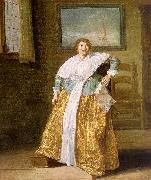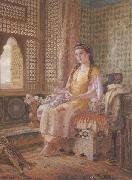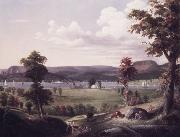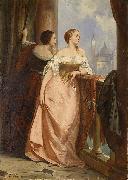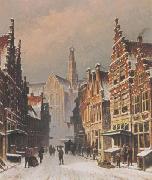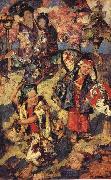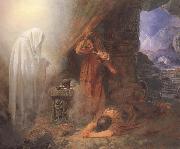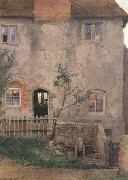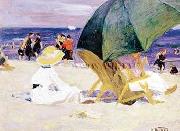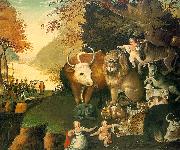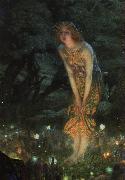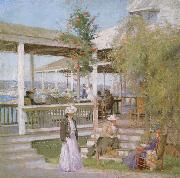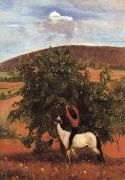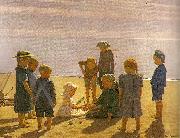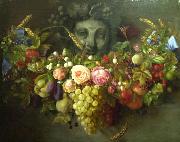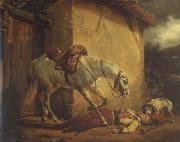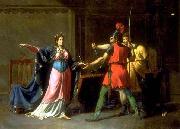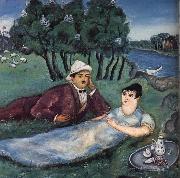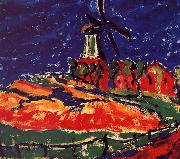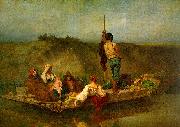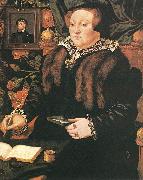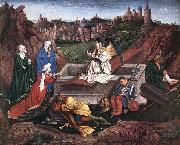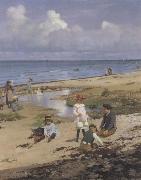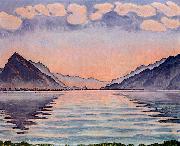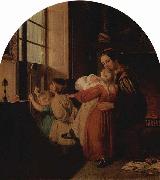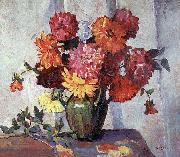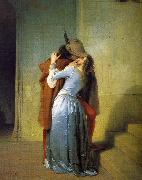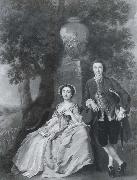|
|
|
|
 |
Daniel Huntington
|
|
(October 4, 1816 -April 19, 1906), American artist, was born in New York City, New York, the son of Benjamin Huntington, Jr. and Faith Trumbull Huntington; his paternal grandfather was Benjamin Huntington, delegate at the Second Continental Congress and First U.S. Representative from Connecticut.
In 1835 he studied with Samuel F.B. Morse, and produced "A Bar-Room Politician" and "A Toper Asleep." Subsequently he painted some landscapes on the Hudson river, and in 1839 went to Rome. On his return to America he painted portraits and began the illustration of The Pilgrim's Progress, but his eyesight failed, and in 1844 he went back to Rome.
Returning to New York around 1846, he devoted his time chiefly to portrait-painting, although he painted many genre, religious and historical subjects. From 1851 to 1859 he was in England. He was president of the National Academy from 1862 to 1870, and again in 1877-1890.
|
|
|
|
|
|
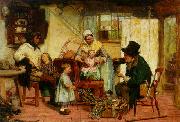 |
David Henry Friston
|
|
(1820 - 1906) was a British illustrator and figure painter in the Victorian Era. He is best remembered as the creator of the first illustrations of Sherlock Holmes in 1887, as well as his illustrations of the controversial female vampire story Carmilla (1872). He is also remembered for his illustrations accompanying reviews of Gilbert and Sullivan operas and plays of W. S. Gilbert in The Illustrated London News and the Illustrated Sporting and Dramatic News in the 1870s and 1880s.
|
|
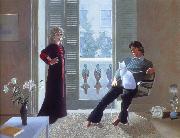 |
david hockney
|
|
Born: 9 July 1937
Birthplace: Bradford, England
Best Known As: British pop artist and critic |
|
|
|
|
|
|
|
|
|
|
|
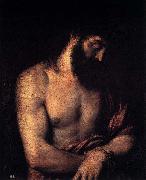 |
Ecce Homo
|
|
are the Latin words used by Pontius Pilate in the Vulgate translation of the John 19:5, when he presents a scourged Jesus Christ, bound and crowned with thorns, to a hostile crowd shortly before his Crucifixion. The King James Version translates the phrase into English as Behold the Man. The scene is widely depicted in Christian art.
The Ecce homo is a standard component of cycles illustrating the Passion and Life of Christ in art. It follows the Flagellation of Christ, the Crowning with thorns and the Mocking of Christ, the last two often being combined. The usual depiction shows Pilate and Christ, the mocking crowd and parts of the city of Jerusalem.
But, from the 15th century, devotional pictures began to portray Jesus alone, in half or full figure with a purple robe, loincloth, crown of thorns and torture wounds, especially on his head. Similar subjects but with the wounds of the crucifixion visible (Nail wounds on the limbs, spear wounds on the sides), are termed a Man of Sorrow(s) (also Misericordia). If the "Instruments of the Passion" are present, it may be called an Arma Christi. If Christ is sitting down (usually supporting himself with his hand on his thigh), it may be referred to it as Christ at rest or Pensive Christ. It is not always possible to distinguish these subjects.
|
|
|
|
|
|
|
|
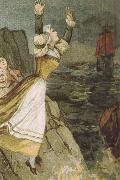 |
eduard hanslick
|
|
German music critic, aesthetician and pioneer of musical appreciation. He studied music with Tom??šek and read law at Prague University, writing his earliest essays for the Prague journal Ost und West and for the Wiener Musikzeitung, the Sonntagsblätter and the Wiener Zeitung. From 1849 to 1861 he was a civil servant, chiefly for the ministry of culture, meanwhile writing for the Presse, publishing his important book Vom Musikalisch-Schönen (1854) and lecturing on music appreciation at Vienna University, becoming full professor in 1870. He was also active as a musical emissary and helped promote the standardization of musical pitch. Among his long-standing friends were Brahms and the philosopher Robert Zimmermann. Though his aesthetic enshrined the classical ideals of orderliness and formal perfection, his interests were limited to the music of his own time. |
|
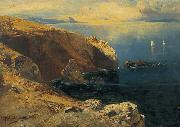 |
Eduard Hildebrandt
|
|
(1818 - October 25, 1868) was a German painter.
He served as apprentice to his father, a house-painter at Danzig. He was not twenty when he came to Berlin, where he was taken in hand by Wilhelm Krause, a painter of sea pieces. Several early pieces exhibited after his deathea breakwater, dated 1838, ships in a breeze off Swinemunde (1840), and other canvases of this and the following yeareshow Hildebrandt to have been a careful student of nature, with inborn talents kept down by the conventionalisms of the formal school to which Krause belonged.
Accident made him acquainted with masterpieces of French art displayed at the Berlin Academy, and these awakened his curiosity and envy. He went to Paris, where, about 1842, he entered the atelier of Isabey and became the companion of Lepoittevin. In a short time he sent home pictures which might have been taken for copies from these artists. Gradually he mastered the mysteries of touch and the secrets of effect in which the French at this period excelled.
He also acquired the necessary skill in painting figures, and returned to Germany, skilled in the rendering of many kinds of landscape forms. His pictures of French street life, done about 1843, while impressed with the stamp of the Paris school, reveal a spirit eager for novelty, quick at grasping, equally quick at rendering, momentary changes of tone and atmosphere.
After 1843 Hildebrandt, under the influence of Humboldt, extended his travels, and in 1864-1865 he went round the world. Whilst his experience became enlarged his powers of concentration broke down. He lost the taste for detail in seeking for scenic breadth, and a fatal facility of hand diminished the value of his works for all those who look for composition and harmony of hue as necessary concomitants of tone and touch.
In oil he gradually produced less, in water colours more, than at first, and his fame must rest on the sketches which he made in the latter form, many of them represented by chromolithography. Fantasies in red, yellow and opal, sunset, sunrise and moonshine, distances of hundreds of miles like those of the Andes and the Himalaya, narrow streets in the bazaars of Cairo or Suez, panoramas as seen from mast-heads, wide cities like Bombay or Pekin, narrow strips of desert with measure-less expanses of skyall alike display his quality of bravura. Hildebrandt died at Berlin on the 25th of October 1868.
|
|
|
|
|
|
|
|
|
|
|
|
|
|
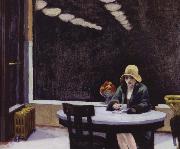 |
edward hopper
|
|
American painter, printmaker and illustrator. He was brought up in a town on the Hudson River, where he developed an enduring love of nautical life. When he graduated from Nyack Union High School in 1899, his parents, although supportive of his artistic aspirations, implored him to study commercial illustration rather than pursue an economically uncertain career in fine art. He studied with the Correspondence School of Illustrating in New York City (1899-1900). He continued to study illustration at the New York School of Art (1900-1906), under Arthur Keller (1866-1925) and Frank Vincent Du Mond (1865-1951), but began to study painting and drawing after a year. Hopper began in the portrait and still-life classes of William Merrit Chase, to whose teaching he later referred only infrequently and disparagingly. He preferred the classes he took with Kenneth Hayes Miller and especially those of Robert Henri. Hopper s skill won his fellow students respect, as well as honours in the school where, by 1905, he was teaching Saturday classes.
|
|
 |
Edward lamson Henry
|
|
A popular and prolific genre artists at the end of the 19th century
American , 181-1919
|
|
|
|
|
|
|
|
|
|
|
|
|
|
|
|
|
|
|
|
|
|
|
|
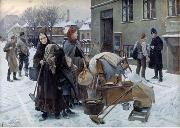 |
Erik Henningsen
|
|
(29 August 1855 - 28 November 1930) was a Danish painter and illustrator. He is best known for his Social Realist paintings of poor and exposed groups in the 1880s and 1890s. He was the younger brother of Frants Henningsen who was also a painter.
Erik Henningsen was born on 29 August 1855 in Copenhagen to Frants Ludvig Henningsen (1820-1869), a grocer, and Hilda Charlotte Christine ne Schou (1824-1880). He showed an early artistic talent and was articled to decorative painter A. Hellesen. He also took drawing lessons privately with C. V. Nielsen and was admitted to the Royal Danish Academy of Fine Arts in 1873. He graduated in 1877 and won several awards and distinctions, including the Academy's Annual Medal in 1887 and 1890, the Ancher Prize in 1889. |
|
|
|
|
|
|
|
|
|
|
|
|
|
|
|
|
|
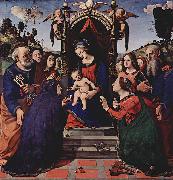 |
Fitz Henry Lane
|
|
(December 19, 1804 - August 14, 1865) was an American painter and printmaker of a style that would later be called Luminism, for its use of pervasive light.
Fitz Henry Lane was born on December 19, 1804, in Gloucester, Massachusetts. Lane was christened Nathaniel Rogers Lane on March 17, 1805, and would remain known as such until he was 27. It was not until March 13, 1832 that the state of Massachusetts would officially grant Lanees own formal request (made in a letter dated December 26, 1831) to change his name from Nathaniel Rogers to Fitz Henry Lane. As with practically all aspects of Lanees life, the subject of his name is one surrounded by much confusioneit was not until 2005 that historians discovered that they had been wrongly referring to the artist as Fitz Hugh, as opposed to his chosen Fitz Henry, and the reasons behind Lanees decision to change his name, and for choosing the name he did, are still very unclear.
|
|
|
|
|
|
|
|
 |
Francis Holman
|
|
(1729-1784) was a British maritime painter, little recognised during his own lifetime, but whose paintings are now sought aftereHe is also notable as the teacher of Thomas Luny.
He was born in Ramsgate and baptized on 14 November 1729 at St Laurence-in-Thanet, Ramsgate.[1] He was the eldest son and second of six children of Francis Holman (1696-1739), and his wife, Anne Long (1707-1757). His father was a master mariner, and his grandfather a Ramsgate cooper. His younger brother, Captain John Holman (1733-1816), maintained the family shipping business and remained close to Francis throughout his life. Young Francis would certainly have been immersed in the maritime world during his up-bringing; the legacy of this early knowledge is a wealth of detail and accuracy in his later work.
The moonlight Battle of Cape St Vincent, 16 January 1780 by Francis Holman, painted 1780
A sixth-rate British man of war off Dover, by Francis Holman, 1777
A small shipyard on the Thames, by Francis Holman, between 1760 and 1784Francis Holman lived in at least five addresses in Wapping on the Thames in London. He married, firstly, Elizabeth, and they produced 3 sons; John (b. 1757), and two more sons, both named Francis, who died in infancy. Elizabeth's death is unrecorded, but on 7 May 1781 he married, secondly, Jane Maxted (c.1736-1790). He was apparently childless when he wrote his will in 1783.
|
|
|







